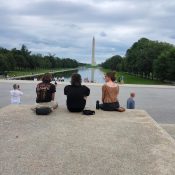Author: Trevor Hattabaugh
Emerging Professional View: ASLA Conference 2024
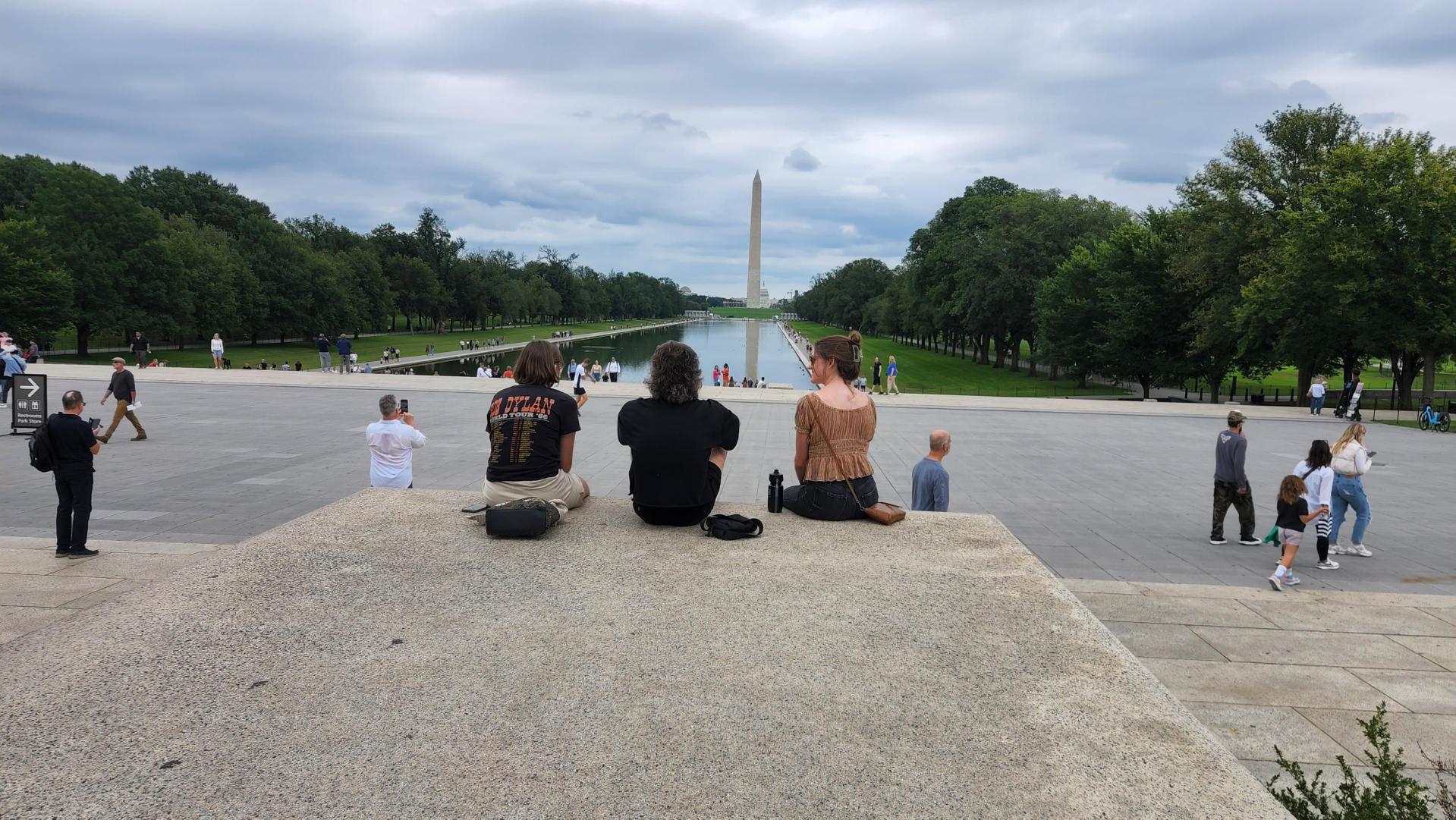
UO students Mia Owen, Momo Kelley, and Eva Kahn enjoy DC’s landscapes / Photo: Cameron Coronado
As the morning sun crested the Washington Monument on Saturday, October 5, 2025, a group of landscape architecture professionals, fanatics, visionaries, creatives, and diehards descended upon Washington, DC. Not only was this my first time in DC, it was my first time attending ASLA’s national conference, and I was especially excited to ride the Metro and visit the US Botanic Garden. Surrounded by iconic American landscapes, the 2024 ASLA Conference on Landscape Architecture kicked off with the theme of ‘Insight’. Weather permitted, lanyards jostled, and networking commenced for an unforgettable week.
Paying homage to famous landscapes and paying attention to the leaders at the cutting edge of this profession left feet sore and sleep sparse. In the shadow of the nation’s capital, insight was shed on the world’s most pressing challenges – climate change, equity, and the benefits of interdisciplinary collaboration. Students and professionals attended compelling talks, honored award winners, asked nuanced questions, revealed LARE mysteries, reacquainted with old friends, established new LinkedIn connections, sat on exhibitor’s benches, and filled free tote bags with business cards. It was a rendezvous that reminded me of what a small, fascinating world it is that we live in. As a newly initiated novice, here is my account of the graduate student experience at the conference.
Keynote Speakers
I was particularly excited for the first keynote speaker, Dr. Lyla June Johnston, a scholar and indigenous activist, who delivered an inspiring speech on land stewardship, and shared insight of how landscape architects can learn from indigenous land management philosophy and practice. Julia Watson, professor, designer, and author of award-winning book, Lo-TEK: Design by Radical Indigenism, was the second keynote speaker, who shared stories of generational indigenous technology that transcends narrow definitions of contemporary design, like living tree root bridges in Northern India, and Qasab reed floating islands in Southern Iraq. Both Johnston and Watson encouraged attendees to widen their scope of what landscape architecture can do, emphasizing that while the profession of Landscape Architecture is relatively young, the practice of conscious symbiosis is as old as time.
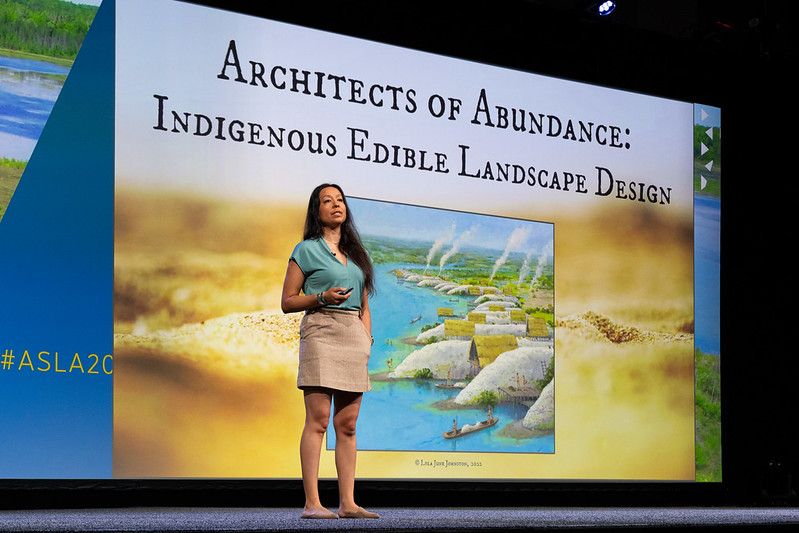
Dr. Lyla June Johnston / Photo: ASLA
New Leadership
The conference also saw leadership transitions that included ASLA President SuLin Kotowicz pass the baton to ASLA President-Elect, Kona Gray. In her time as president, SuLin advocated nature-based solutions to decision makers, with the enhanced leverage of Landscape Architecture’s recent STEM designation. She also traveled around the country to hear from many professionals and local chapters. I was lucky enough to meet SuLin on her trip to Boise, Idaho, when ASLA executives stopped at the office where I was interning, The Land Group Inc., to gain a regional perspective. I was impressed and honored with her leadership and commitment to listening. As the community thanks SuLin for her service, we look to Kona Gray for direction in the coming year. Kona Gray is an outstanding speaker and individual, who has given back to the community through his practice, as well as serving on countless committees, juries, boards, and fellowships, and we are excited for him to light the way as the new ASLA president in 2025.
Best Talks (that I attended)…
Rewilding a Post-industrial Landscape: A Story About Diversity with speakers Heather Blaikie, Marni Burns, and Eric Rothstein.
This talk shared strategies of preserving, enhancing, and restoring native ecosystems at Sojourner Truth State Park on the Hudson River. It also shared insight on when and where to use a light touch to tell stories of land history, while also demonstrating practicality towards ecological function by collaborating with scientists.
The Curation, Choreography, and Culture of Linear Landscapes with speakers Cindy Zerger, Nate S. Cormier, and Megan Born.
As America reexamines its relationship with urban infrastructure, landscape architects stand to help shape the next stage of multimodal growth. The presenters in this talk all shared successful projects of connecting communities from a city, to urban, to site scale. This talk asked meaningful questions on how to update and reconnect urban spaces, without erasing their identity.
Designing for Energy Transition: The Opportunity of Renewable Energy Landscapes with speakers Nicholas Pevzner, Dr. Yekang Ko, and Jasper Hugtenburg.
Renewable energies are most effective when seamlessly integrated into landscapes. This talk offered research, practice, and precedents of renewable energy technology designed for in landscape architecture. The speakers also challenged designers to become literate in the technical aspect of renewable energy technology, and to advocate for it in their projects.
Shifting Ground – Homelessness and the Fight for Equitable and Compassionate Design with speakers Jerome Chou, Brice Maryman, and Jean Yang.
Urban settings have unprecedented wealth inequality, a shortage of housing, and expensive property values. These problems have contributed to a growing population of individuals experiencing homelessness. While it is not solely the Landscape Architect’s job to solve this complicated issue, this talk highlighted the unique position design of outdoor spaces finds itself. Speakers shared case studies of projects that showed compassion instead of hostility, and dared other to as well.
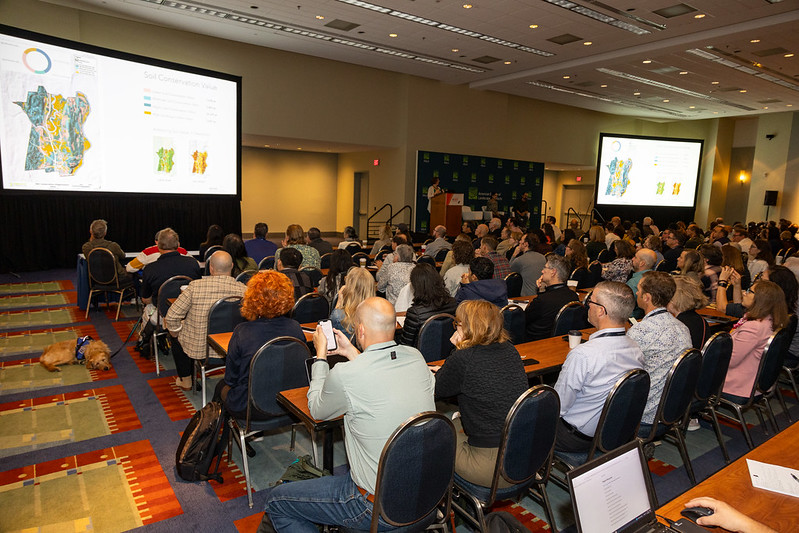
Unlocking the Carbon Potential of Soils: Christopher R. Ng-Hardy, Gillian T. Davies, Rachel W. Lindsay / Photo: ASLA
The Expo
In a frenzy of elaborate display booths, the Expo floor offered a faster, less reflective, pace to the conference. Folks nerded out to site furnishings, playground equipment, pavers, and niche software, taking notes on what to spec on their next detail sheet. The Expo also featured a bookstore with author signings and hot titles like The Topography of Wellness by Sara Jensen Carr (ASLA Award of Excellence in Communication).
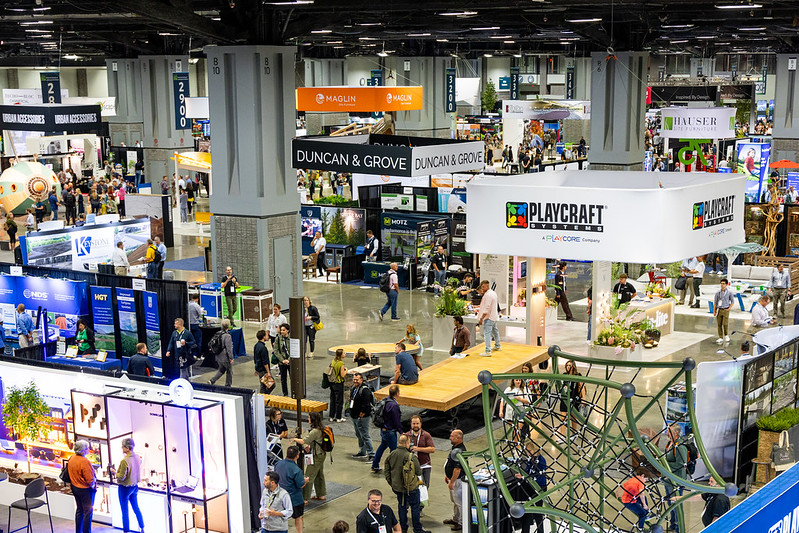
Expo Floor / Photo: ASLA
Social Events
In “work hard, play hard” fashion, conference attendees also enjoyed themselves at sketch demos, mixers, and canine socials. One highlight of after-hour happenings was the extravagant 125th ASLA Anniversary Celebration sponsored by Land F/X, complete with games, karaoke, DJ, and photobooths. The four-story Land8 “Happy Hour” also allowed attendees to unwind with a different decade of dance music on each floor at a local DC club on the final evening of the conference.
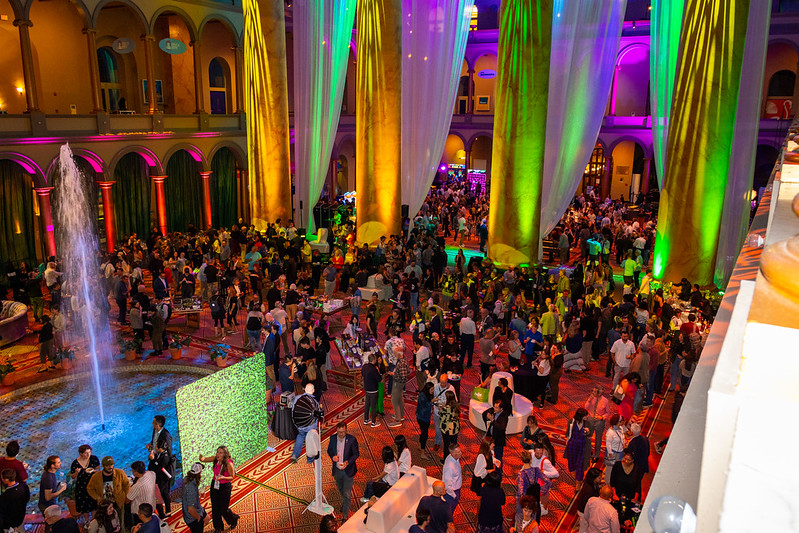
ASLA 125th Celebration sponsored by Land F/X / Photo: ASLA
Conclusion
As those who attended the conference go forth and spread the insight they gained, those who did not attend will be relieved to know they have another chance next year. With all eyes on the 2025 ASLA Conference in New Orleans next fall, it will be exciting to see what trends develop in our dynamic profession, and what new challenges tomorrow brings. Finally, after a historic audio clip of Maya Angelou speaking at the 1995 ASLA National Conference was played, in which she referred to landscape designers as “rainbows in the sky”, Chicago was announced as the site of the 2027 ASLA Conference, after Los Angeles in 2026. These conferences underscore the need for forward-thinking design solutions that respond to evolving environmental and social challenges. As we move ahead, landscape architects will continue to play a critical role in shaping resilient, inclusive, and innovative spaces that benefit both people and the planet.



